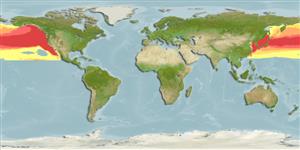Common names from other countries
Teleostei (teleosts) >
Beloniformes (Needle fishes) >
Scomberesocidae (Sauries)
Etymology: Cololabis: Greek, kolos = short, truncated + Latin, labia = lips (Ref. 45335); saira: From the Japanese word 'saira' meaning spear (Ref. 6885).
Environment: milieu / climate zone / depth range / distribution range
Ecology
Marine; pelagic-oceanic; oceanodromous (Ref. 51243); depth range 0 - 230 m (Ref. 9339). Subtropical; 67°N - 18°N, 117°E - 108°W (Ref. 54338)
North Pacific: Korea (Ref. 37630) and Japan eastward to Gulf of Alaska and southward to Mexico. Highly migratory species.
Length at first maturity / Size / Weight / Age
Maturity: Lm 23.7, range 25 - 28 cm
Max length : 40.0 cm SL male/unsexed; (Ref. 39882); max. published weight: 180.00 g (Ref. 56527); max. reported age: 4 years (Ref. 72462)
Dorsal spines (total): 0; Dorsal soft rays (total): 9 - 12; Anal spines: 0; Anal soft rays: 12 - 15; Vertebrae: 62 - 69. Caudal fin broadly and finely forked; pectorals small, truncate, first ray notably flattened (Ref. 6885). Dark green to blue on dorsal surface, silvery below, small bright blue blotches distributed haphazardly on sides; fins on lower part of body pale, others with darkened rays (Ref. 6885). Branchiostegal rays: 12-15 (Ref. 36573).
Adults are generally found offshore, usually near surface, in schools (Ref. 2850). Juveniles associate with drifting seaweed (Ref. 12114, 12115). Feed on small crustaceans, and eggs and larvae of fishes. May glide above the surface of the water when moving away from predators. Prey of Thunnus alalunga and other scombrids (Ref. 9339). Oviparous, with larvae neustonic (Ref. 36573). Eggs are attached to one another and to floating objects via filaments on the shell surface (Ref. 36573). Utilized dried or salted, canned and frozen; also used for fishmeal and pet food; can be pan-fried and broiled (Ref. 9988).
Eschmeyer, W.N., E.S. Herald and H. Hammann, 1983. A field guide to Pacific coast fishes of North America. Boston (MA, USA): Houghton Mifflin Company. xii+336 p. (Ref. 2850)
IUCN Red List Status (Ref. 130435)
CITES (Ref. 128078)
Not Evaluated
Threat to humans
Harmless
Human uses
Fisheries: highly commercial
Tools
Can't connect to MySQL database fbquizv2. Errorcode: Connection refused
